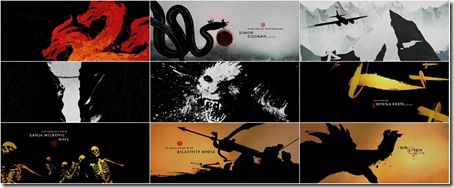Since I tend to post as many links as I do write more substantial posts these days, I thought I’d meet myself half way and start making posts about blogs I find useful and enjoyable and that you might like, too. For the first of these ‘you should be reading’ posts, I’d like to draw your attention to the Art of the Title Sequence. This blog is very focused, looking exclusively at the opening sequences of films and, occasionally, of television shows. Opening titles can often be very boring, but when done well they can be amazing works combining graphics, sound, symbolism and energy. Sure, the Bond films have made a cgi-artform out of their attempts to one-up the previous entry in the franchise (and I love the vector graphic cards from Casino Royale) but so many films have wonderful but woefully underappreciated title sequences, well worth examination on their own right. I know one of my favourite bits of my doctoral thesis was a look at the title sequences of the first two Spider-Man films. So, the Art of the Title Sequence brings a focused critical eye on the best (and primarily on the best; it’s too easy to pick apart weak titles) opening sequences out there. As a sample, here’s an excerpt from a recent post on The Mummy 3 (of which the titles are far and away the best bit):
What immediately comes to mind upon viewing these end titles as a stand alone consideration, is that there is great discipline in the master calligrapher’s graceful yet contrasting Chinese brush strokes. His magic carpet ride reminds one of Masaki Kobayashi’s “Hoichi the Earless”; only here the Chinese characters -and Kanji, respectively- become life-taking daggers rather than a life-saving shield. Too, I am reminded of splattered ink at the point of impact and the panning flight of a classic aircraft -both seen in the aforeposted “El Don,” in addition to owing an incalculable debt to the “3OO” end titles and, in a true sense, to Frank Miller.

